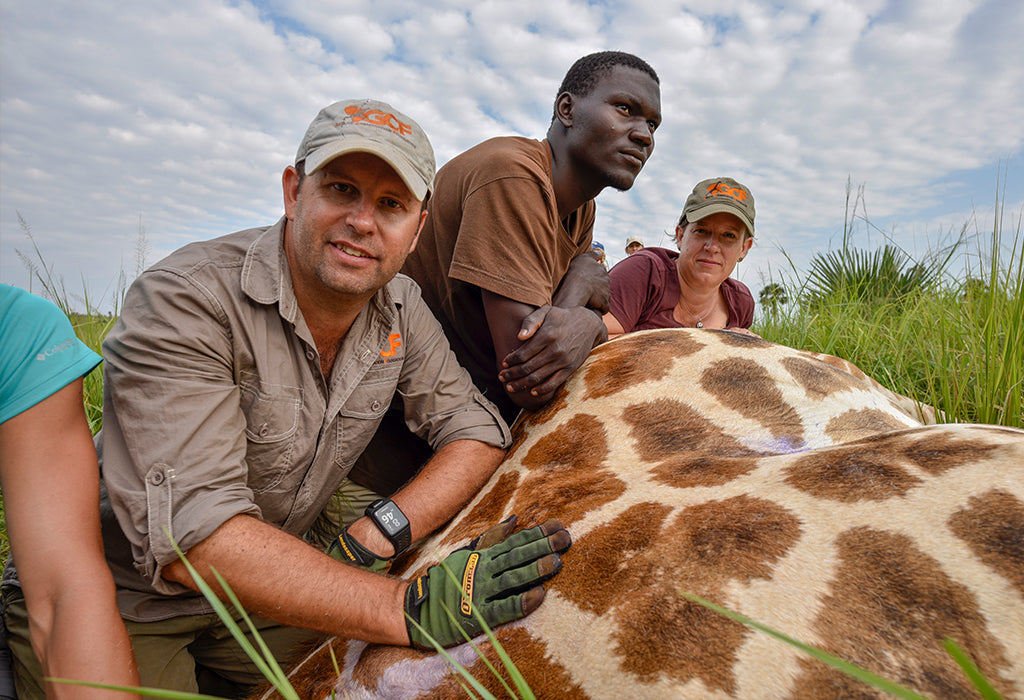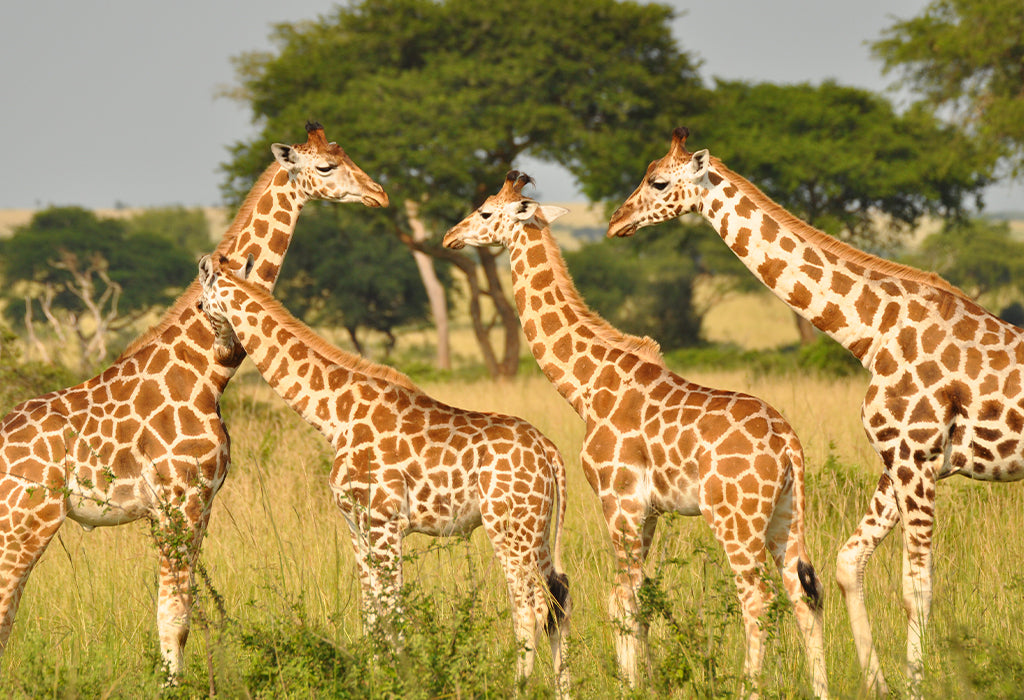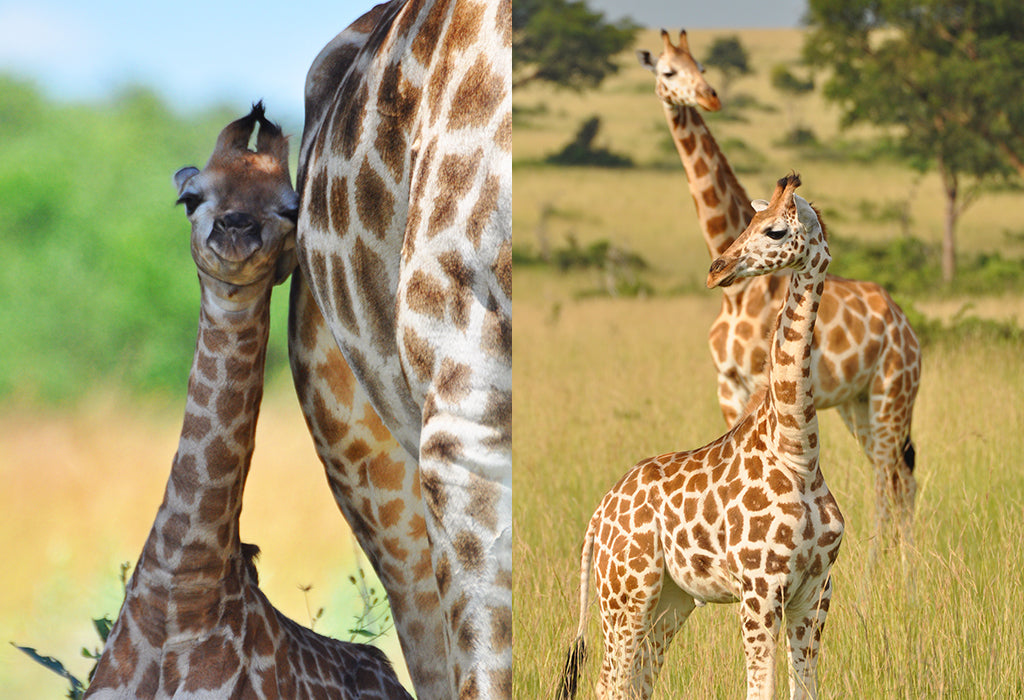
A reticulated giraffe. Photo courtesy of GCF.
Why Giraffes are Facing a “Silent Extinction”
Instantly recognizable but surprisingly under the radar, Africa’s giraffe population has declined by close to 30% in the last 30 years.
When Stephanie Fennessy, an environmental engineer, and Dr. Julian Fennessy, a biologist, met on a watershed study in Namibia in 1999, neither could have predicted they’d merge their lives—and their passion for the world's tallest mammals. “The more we looked into it, the more we realized how little information there was about giraffe. Their numbers were dropping rapidly, but no one seemed to notice,” Stephanie recalls. “We called it a silent extinction.”
The husband-and-wife team, who now live in Windhoek, Namibia, with their two young kids, co-founded the Giraffe Conservation Foundation to stop the disappearance of these gentle giants from the African landscape. They are the only organization concentrating solely on the conservation and management of giraffe in the wild throughout Africa, which can sometimes mean sitting in a car for several hours a day monitoring a giraffe’s movements. GCF also does path-breaking research into species DNA, and were behind the recent discovery that there are actually four distinct giraffe species, not one, as previously thought. Stephanie and her family visited our NYC headquarters this past summer for a fascinating chat about how their small organization has imparted a big impact on the understanding and preservation of these towering figures.

Julian and Stephanie Fennessy on a giraffe translocation, with a member of the Uganda Wildlife Authority. Photo courtesy of GCF.
Tell us a few things about the giraffe that we don’t know.
Giraffe are just the most amazing animals. They look so quirky and I never tire of watching them in the wild. Did you know that every giraffe looks different? You can identify each individual giraffe by their coat pattern. Giraffe are the world’s tallest mammals—at birth, a giraffe will be taller than most of you. If you have ever watched a giraffe drinking, you might have realized that their neck is too short to comfortably reach the ground. So to drink, giraffe first have to splay their forelegs and/or bend their knees. This puts them into a very vulnerable position, so they spend a lot of time watching their environment before bending down to drink. This might be one of the reasons why they have adapted specially to survive with little water. Most giraffe only drink once every few days—during our first five years of research in northwestern Namibia, we never saw a giraffe drink!
Where are giraffe found?
They’re found all over Africa—historically, in most parts south of the Sahara. Today they’re in 21 countries, but they’ve become extinct in at least 7 countries in the last 50 years.
What is the mission of Giraffe Conservation Foundation?
We started GCF to save all the giraffe in Africa. Their numbers have been declining rapidly over the last 30 years, and we wanted to make sure giraffe remain with us so that our children can see them in the wild when they grow up. It’s important to note that we don’t see saving the giraffe as an isolated project; by saving one species, you automatically give other animals a better chance at survival, too.
"We can’t just come in and say, 'We’re going to save the giraffe' by ourselves."

Nubian giraffe herd in Murchison Falls National Park. Photo courtesy of GCF.
What are the main challenges facing the giraffe in Africa?
Their biggest threat is habitat loss. There are just more and more people and less and less space for animals to live in. That comes combined with poaching in some areas and disease. But in the end, it is humans who are the threats to the giraffe.
Tell us about translocation—moving giraffe to other locations in Africa for protection.
A very important part of our conservation measure is translocating giraffe back into their natural ranges, where they have historically occurred. It sounds quite easy to move giraffe, but you usually have to individually capture them, which is quite a feat. They’re big animals and are difficult to capture, so it comes with big risks, both to the people involved and the animals. We then reintroduce them to areas where they haven’t occurred in a long time. Once you give them space and security, they do really well. Even with a gestation period of 15 months, numbers can go up quite quickly.
To do this, we work with local communities all over Africa—in Niger, for example, we recently reintroduced them into an area they haven't been in 50 years. There we worked with the local Tuareg community to get them excited about the giraffe and to look after them. I love this story: In the first few days after the giraffe arrived, they were very mobile, and one Tuareg leader got on his motorbike to follow them and then had to drive about 30km to get cell phone reception so he could call us and let us know where they were. In Kenya we work with the local Samburu and Maasai people to get them involved. We call them Twiga Walinzi, or “giraffe guards” in Swahili. We have a camera network which the local people monitor to help us find out where the giraffe live. We also work with international partners, like San Diego Zoo Global.

Photo courtesy of GCF.
What are some examples of your successes?
We realized that it’s really important to work with African governments—we can’t just come in and say, “We’re going to save the giraffe” by ourselves. There’s no one solution to giraffe conservation, and the most important thing we can realize is the necessity of working with partners.
How will Chantecaille's donation benefit giraffe conservation?
After an absence of more than 100 years, GCF partnered with African Parks and Malawi’s Department of National Parks and Wildlife to establish a new giraffe population in Malawi. In October 2018 and after a 1,500-mile road journey from South Africa, giraffe were successfully reintroduced into Majete Wildlife Reserve in southern Malawi. GCF is now planning to add to this new population and bring another group of giraffe to Majete in late 2019. Moving giraffe comes at a high cost—and Chantecaille’s donation would contribute to this important giraffe conservation program in Malawi.
Additionally, through our partnership with Chantecaille, we hope to reach a different group of people with our work—we are a very small organization and our reach is rather limited; we don't have the powers of the big conservation outfits. A lot of people just haven't realized that giraffe numbers are dropping so drastically, and we hope that by reaching out to different communities we can get the message out there.

Photo courtesy of GCF.






